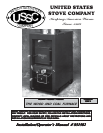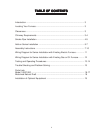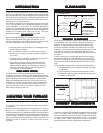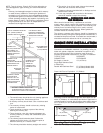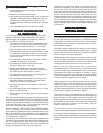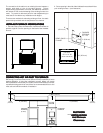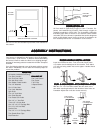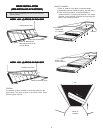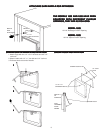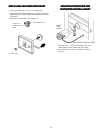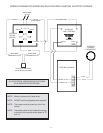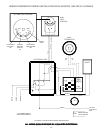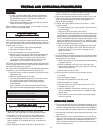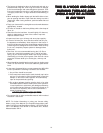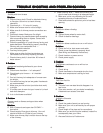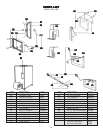
When constructing a single wall smoke pipe, the followingWhen constructing a single wall smoke pipe, the following
When constructing a single wall smoke pipe, the followingWhen constructing a single wall smoke pipe, the following
When constructing a single wall smoke pipe, the following
guidelines must be observed.guidelines must be observed.
guidelines must be observed.guidelines must be observed.
guidelines must be observed.
1.The smoke pipe should be 24 gauge or heavier stain less
steel or black pipe.
2.Secure all joints with three #8 screws.
3.If the smoke pipe must pass through a wall, an approved
insulated or ventilated thimble, at least three times the
diameter of the smoke pipe must be used. (i.e. a 6"
(15.24cm) diameter smoke pipe needs an 18" (45.72cm)
thimble).
4.The smoke pipe should not be used as a chimney.
IMPORTANT INFORMATION FORIMPORTANT INFORMATION FOR
IMPORTANT INFORMATION FORIMPORTANT INFORMATION FOR
IMPORTANT INFORMATION FOR
ALL SMOKE PIPESALL SMOKE PIPES
ALL SMOKE PIPESALL SMOKE PIPES
ALL SMOKE PIPES
The smoke pipe must be constructed and installed so that it
maintains clearances, keeps condensation and creosote
within the pipe, and is capable of withstanding a 2000°F to
3000°F (1093°C to 1649°C) chimney fire.
1.The smoke pipe should slant down toward the furnace a
minimum of 1/4" to the foot. At no time should the pipe
turn downward toward the chimney or run horizontal.
2.There should be no more than two 90 degree elbows.
3. The smoke pipe should never be longer than 6 feet.(1.83m)
If it is absolutely necessary to make a run of more than
six feet (not recommended) use extra support brackets
every 3 feet (.91m).
4.The smoke pipe should never be reduced to a smaller
size than flue opening on the furnace.
5.The smoke pipe should not block the flue of the
chimney or extend into it in any way.
6.A good airtight thimble should be used to hold the
smoke pipe in the chimney. It should be constructed so
the smoke pipe can be removed for cleaning.
7.The smoke pipe should not leave the heated portion of
the building to reach the chimney.
8.The smoke pipe should not pass from one story to the
next before entering the chimney, nor should it pass
through any closed or enclosed space.
9.Heat reclaimers should not be installed or used in the
smoke pipe.
10. The smoke pipe should not be located near or in a walk
way or well traveled area.
11. All male ends of smoke pipe should run or point towards
the furnace.
When you have installed the smoke pipe connecting your furnace
to the chimney, tap the pipe hard with your fingernail. Remember
the sound it makes - it will be a "ting" echoing inside the stove pipe.
If later you tap and hear a muffled thud, you are building up soot
in the pipe and should clean it. This pipe should be cleaned at
least once or twice during the heating season.
DO NOT CONNECT TWO HEATERS TO THE SAME CHIMNEY
FLUE. The National Fire Prevention Association recommends
that woodburning appliances vent into a separate chimney from
gas or oil furnaces. If such an installation is contemplated, first
check with a local building inspector to find out if a separate flue
for a woodburner is required.
If codes allow, use extreme care in making such installations. Be
sure that one pipe is higher than the other so that the two openings
will not be opposite each other. Also, when connecting two
heaters into the same chimney flue, the flue size should be large
enough to handle both heaters. Very few codes and
ADD-ON SERIESADD-ON SERIES
ADD-ON SERIESADD-ON SERIES
ADD-ON SERIES
INSTINST
INSTINST
INST
ALLAALLA
ALLAALLA
ALLA
TIONTION
TIONTION
TION
standards allow same flue connection. Such installations can
cause severe problems. Gas hoods and barometric dampers
allow excess air into the chimney causing cooling of the flue
gases and a greater creosote build-up potential. If the same flue
connections are used, chimneys must be inspected more fre-
quently and the chimney should be cleaned any time the
creosote deposits exceed 1/4" thickness. A creosote fire in such
a chimney can burn out of control because of the air leak through
the barometric damper or gas hood. Keeping the chimney clean
and burning well-seasoned wood is absolutely necessary. This
type of installation does require more frequent inspection and
maintenance.
The downstream series techniqueis the onlyapproved method
for using the 1600 and 1800 furnaces in combination with an
existing gas, oil or electric forced air furnace. While it requires
reworking the main duct system, it typically results in a simpler,
less restrictive installation.
Certification testing establishes the minimum cross-sectional
area for the transfer duct permitted for a specific add-on. A large
transfer duct will allow freer flow of air through the additional
elbows involved in the add-on installation.
Additional space will be required in the furnace room for an add-
on. There must be a room beside the existing furnace for the add-
on and the transfer duct which runs from the hot air plenum of the
existing furnace down to the cold air inlet of the add-on.
While oil, gas and electric furnaces may be connected to
combustible return air ducts in the form of joist panning, wood
furnaces normally require noncombustible return air duct work.
Combustible return ducts connected to an existing oil, gas or
electric furnace need not to be replaced with noncombustible
ducts when an add-on is installed; the add-on connections make
reverse flow during a power failure very unlikely.
Major changes to the main distributionduct system are normally
required in order to route the existing duct over the new hot
plenum of the add-on. Any indivdual ducts connected directly to
registers from the existing plenum also have to be routed over to
the add-on plenum because all of the air must pass through the
add-on before reaching any distribution ductwork.
There are two options for managing the duct alternations. In
some cases, it is more practical to move the existing furnace and
place the add-on in the location it previously occupied. By
locating the add-on where the original furnace was, fewer supply
duct alterations will be needed. On the other hand, alterations to
the return ducts will be needed to re-route them to the new
location of the cold air plenum.
The other option is to leave the existing furnace in its original
location and re-route the supply ducts to the new add-on plenum.
In your design of add-on installations, always choose the approach
that involves using the least elbows. By keeping the number of
elbows to a minimum, duct restrictions and blower noise will be
reduced.
5



